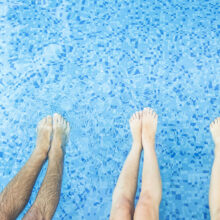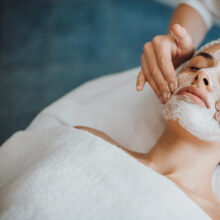My Analysis of some of the Recent 2007 ISPA Spa Industry Study: Learning about Day Spas, Resort/Hotel Spas, Medical Spas, etc.
- Published: Friday, November 23rd 2007
- in Living Well
 My Analysis of some of the Recent 2007 ISPA Spa Industry Study: Learning about Day Spas, Resort/Hotel Spas, Medical Spas, etc.
My Analysis of some of the Recent 2007 ISPA Spa Industry Study: Learning about Day Spas, Resort/Hotel Spas, Medical Spas, etc.
by Susie Ellis
The one good thing about coming down with a cold on Thanksgiving is that you don’t eat as much and you get to catch up on your sleep – and some reading.
For me, that meant reading through the entire new “2007 Spa Industry Study – A profile of the spa industry in the United States & Canada” which I purchased at ISPA in Florida a few weeks ago.
First, let me say that I think there is a lot of good and valuable information in this 100 page report, and I think anyone in the spa business would find it worthwhile to purchase it. It is sure to spark at least one good idea worth the price of the research which is $250 for ISPA members. Although the non-member price isn’t on their website today, my guess is it will be $800 which is what they have charged for other studies. This makes it pretty much of a given that someone will join ISPA (cost around $600) and purchase the study at the same time.
I am going to share with you some of the notes I took going through the study as well as my comments about some of the numbers. At the end of this list I will give you some of my conclusions. I look forward to hearing from others about what they learned and how they interpreted the data in light of their industry knowledge.
80% of spas in this study are day spas.
This is key to keep in mind when reading through this study. Day spas represent such a high percentage of spas overall that while there is lots of great data here, we have to be careful not to infer that the aggregated results speak for the resort/hotel or medical spa industry. On the other hand in many sections data is broken out by spa type, making that information especially useful.
Total spa revenue for the year is down, demand is down (fewer people are going to spas), yet profits are up.
Interesting. Again, I have to remind myself that I need to consider this as a day spa phenomenon. One explanation given is that the new spas which are opening have the lower revenues and lower attendance. Also, that price increases at spas have allowed for greater profits. Qualitative studies verifying this might be helpful. Note to people thinking about opening a new day spa…..not a good time to do so.
We, as an industry, need to attract more people to spas.
Indeed, that is something all of us should rally around. Increasing consumer demand is vital. I would also add that in addition to attracting new people into the spa world, another important and valuable service would be to encourage people who are already going to spas to frequent them more often. Moving people from the periphery into the core (a la Hartman model) would be a huge help as would getting people who go to resort spas to go to day spas (and vice versa). Another option to consider for the future would be to broaden the definition of spa.
Profit margins for spas are averaging 17.4%.
That’s quite an increase since the last profit percentages from ISPA. It is good news and shows that spas are now better managed, more efficient, and more profitable. A glance at the profit figures for other segments once again shows how slanted the data is toward day spas:
Club spa profits 17%
Day spa profits 16%
Medical spa profits 28%
Resort spa profits 24%
Prices have risen substantially at spas and up until now consumers have been paying them.
I agree that this is something I have been seeing also – and frankly I have been surprised that price elasticity has lasted this long. I have noticed greater price elasticity in resort/hotel spas than in day spas. However, as mentioned in the study, raising prices further will likely lower demand.
Growth rates in the number of spas from 1999 – 2006 have averaged about 22% and were 9% in 2005 and 13% in 2006.
I seem to remember that in one of the pre 2005 years the growth rate was over 50%. That would have certainly helped lift the average to the 22% figure. Nevertheless, it still shows steady growth in the number of spas for quite a lengthy period of time.
In the last 7 ½ years the number of spas has tripled.
As we here at SpaFinder are often quoted as saying, there are now more spas in the U.S. than there are Starbucks worldwide. The ISPA numbers do remind us that there are many spas – especially day spas.
Male patrons account for 21% of visits on average.
I have some questions about this figure. I believe the last ISPA study showed that 29% of spa goers are men and our internal figures show that number at 30%. Is “male visits on average” the same as number of men spa goers in this study? It is a bit confusing to me. I can’t imagine that we have decreased in the number of men going to spas. Our figures show (and many resort/hotel colleagues have confirmed) that the figures are almost 60/40 women to men at resort/hotel spas in the U.S. Perhaps this male patron figure is mostly a day spa number.
The average revenue for a spa is $624,000 with the median being $250,000.
This is a good time to remember the difference between average and median (the middle of a distribution) from math class. We can see that the large difference in this study is a result of hotel/resort spas having much higher revenues than day spas thus bringing the average up while the mean stays low due to the huge number of day spas in the study. Interestingly, our recent SpaFinder Day Spa Report also showed that day spas either have small revenue (more than 50% of spas have revenue of less than $250,000 per year) or have revenue over $1 million. Very few were in the middle section.
New spas being built are smaller. In 2007 the average spa built was 3,800 square feet and the median was 2,100 square feet. Newer spas are not putting in as many hydrotherapy features.
This all makes good sense. If we are going to have so many spas, we might as well have them be smallish so that there is enough demand to go around. Also, as many of us have known for a long time, those hydrotherapy rooms are expensive and not such an easy sell.
About 2-3% of spas go out of business each year. 14% are no longer defining themselves as spas.
These are good numbers to know and, I believe, are new in that no one has asked this question in a study before. The 14% number is of particular interest to me. If these places are no longer considered spas by ISPA’s definition, I wonder what they are now. Entirely different businesses? Are they now hair salons? Nail salons? Specialty facilities which give only massage or only facials (which do not count in ISPA’s definition of spa)?
On average a spa carries 2.4 skin care lines. 65% of spas do not private label a skin care brand. 85% of day spas do not have their products available on their internet site.
These numbers do not surprise me and I believe show some areas where more money could be made.
There is a spa labor shortage with the most openings being for massage therapists (24,000) followed by aestheticians and nail technicians. There are 6,600 spa directors and manager positions open industry-wide.
We learned at the Global Spa Summit in May that the labor shortage in the spa industry is not just a U.S. phenomenon but something many countries are experiencing. These latest research numbe
rs help substantiate just exactly how much of a shortage we have here in the U.S. In addition, the study also showed that resort/hotel spas have the greatest challenge when it comes to staff retention and that the most difficult positions to fill are those of nail technicians.
Canada’s spa industry is in a healthier position with the demand outpacing supply.
I am thinking that with the recent strengthening of the Canadian dollar to the U.S. dollar, this might be a great time to be a Canadian in the spa industry!
ISPA members are comprised of only 35% day spas and 54% resort/hotel spas.
This is a very important figure which likely explains why so many people who attend ISPA or are members of ISPA may think that the results of this study either are not an accurate picture of the story they are seeing, or that they are doing a great job in comparison. Fortunately, a close read of the entire report will help sort this all out however it is very important to read the entire study.
Here are my conclusions:
1. Increasing industry demand is important.
2. Discouraging more people from opening new day spas is probably a good idea.
3. Widening the definition of spa my serve our industry better instead of narrowing the definition.
4. While I like aggregating all of the spa industry figures together to get an industry revenue figure, the aggregation doesn’t work so well for other figures. Caution folks that the top line numbers slant toward day spas.
5. Be careful when using the term “maturity.” It’s a business cycle term that comes right before “decline” and “death.” While there may be truth to talking about the day spa segment maturing, it is not a word I would use in the same sentence as resort/hotel spas or medical spas – or for that matter the spa industry as a whole.
6. Supporting quality research is a good idea. Numbers do help us understand the story. Buy the ISPA study.
**
If you wish to be put on a list that automatically sends my blog posts to your email, just let dulcy.gregory@spafinder.com know and she will add you to that list. Thanks so much!


